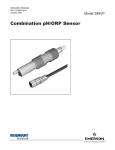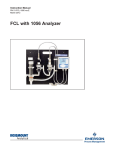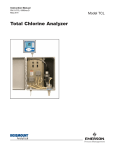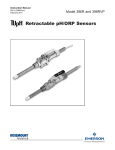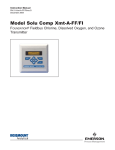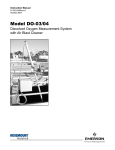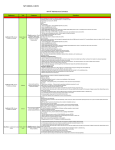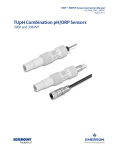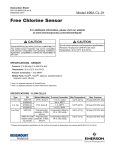Download Emerson 3200 Instruction manual
Transcript
Instruction Manual 51A-3200HP/rev.F January 2011 Model 3200 HP High Purity Water pH Sensor with pHaser Flowing Junction TM For additional information, please visit our website at www.emersonprocess.com/raihome/liquid/ inch mm SPECIFICATIONS Minimum Conductivity: 0.4 µS/cm Sample Temperature: 0°C to 70°C (32°F to 160°F) Sample Inlet Pressure: 5 to 10 psig (134-170 kPa abs); no back pressure allowed; sample must drain to open atmosphere Wetted Materials: Silicone, polycarbonate/ polyester, glass, stainless steel, PVDF, Viton1 1. Viton is a registered trademark of DuPont Performance Elastomers. CAUTION SENSOR/PROCESS APPLICATION COMPATIBILITY The wetted sensor materials may not be compatible with process composition and operating conditions. Application compatibility is entirely the responsibility of the user. FIGURE 1 ATEX DIRECTIVE Flow cell nut Special Conditions for safe use 1. All pH/ORP sensors have a plastic enclosure which must only be cleaned with a damp cloth to avoid the danger due to a build up of an electrostatic charge. 2. All pH/ORP sensor Models are intended to be in contact with the process fluid and may not meet the 500V r.m.s. a.c. test to earth. This must be taken into consideration at installation. PN 3200HP pH sensor INSTALLATION 1. Refer to Figure 1 for dimensions of the mounting plate and the positions and diameter of the mounting holes. 2. Remove the bag containing the diffuser plate from the flow cell. Place the diffuser plate flat in the bottom of the flow cell. See Figure 2. Do not install the sensor yet. 3. Connect the sample and drain lines to the flow cell. Process connections are ¼ inch FNPT. The flow cell must drain immediately to open atmosphere. Do not use a long or convoluted drain line. PN 34083-00 Diffuser Flow cell FIGURE 2 MODEL 3200 HP INSTALLATION PUTTING THE 3200HP SENSOR IN SERVICE 1. Wire the cable to the analyzer. See the wiring diagrams in the wiring section. 2. Start the sample flow to fill the flow cell with water. 3. Unscrew the clear plastic nut on the flow cell and slip the nut over the sensor. See Figure 2. Remove the vinyl cap from the end of the sensor and place the sensor in the water in the flow cell. CAUTION WARNING The solution in the protective cap may cause skin or eye irritation. 4. 5. 6. 7. 8. Keep the capillary disc wet. See Figure 7. If the disc dries out, it cannot be rehydrated, and it must be replaced. Do not remove the shipping plug from the tube connected to the sensor. Lift the reservoir bottle out of the clip holding it to the backplate. Unscrew the cap and lay it on its side in a clean place. Do not remove the protective cap attached to the filter. Pour 500 mL of reference solution (PN 9210391) into the reservoir. Replace the reservoir cap. Remove the shipping plugs from the reservoir filter and the electrolyte tube. Connect the electrolyte tube to the filter by pressing the luer fitting on the tube onto the luer fitting on the filter. Invert the reservoir and slide it back into the clip. A few drops of solution may drip out of the air vent. Bleed air bubbles from the electrolyte tube and sensor. a. Loosen the bleed screw until it is engaged by only about one thread. Watch for bubbles flowing down the electrolyte tube and out the bleed port. b. Once the last bubble has appeared at the bleed port allow an additional 2 mL of solution to escape. Use a paper towel to soak up the electrolyte. Tighten the bleed screw. c. Bubbles may still remain trapped in the 2 FIGURE 3 FIGURE 4 sensor. To remove them, take the sensor out of the flow cell and hold it with the end of the sensor slightly tilted above horizonFIGURE 5 tal. Keep the capillary disc facing up. Loosen the bleed screw and let about 2 mL of solution escape. d. Rotate the sensor slightly in the direction shown by the arrow in Figure 6 until the capillary disc is about 60° from vertical. Watch for bubbles leaving the port. Bleed an additionFIGURE 6 al 2 mL of solution after the last bubble has escaped. Tighten the bleed screw. 9. Connect the VP cable to the sensor. The sensor connector is keyed to ensure proper mating with the cable receptacle. Once the key has slid into the mating slot, hand tighten the connection by turning the knurled ring clockwise. 10. Place the sensor in the flow cell. Be sure the capillary disc faces forward. Tighten the flow cell nut. 11. Adjust the sample flow Capillary until it is between 1 and Disc 3 gph (60 to 180 mL/min). For best results flow should be constant. FIGURE 7 MODEL 3200 HP WIRING WIRING The 3200HP sensor is available with Variopol (VP) quick disconnect cable only. Although earlier versions of the sensor were supplied with a VP6 cable, current versions use a VP8 cable. The wiring diagrams in the manual are for VP8 cable only. If you have a VP6 cable, refer to the wiring diagrams on our website, www.raihome.com. The table below gives part numbers for VP6 and VP8 cable: Cable length VP6 VP8 10 ft. (3.0 m) 20 ft. (6.1 m) 30 ft. (9.1 m) 23645-10 23645-11 23645-12 24281-06 24281-07 24281-08 If the part number is missing or not visible, identify the cable by disconnecting it from the sensor and counting the number of gold contacts on the cable receptacle (not on the sensor). VP6 cable has six contacts; VP8 has eight contacts. Do not connect the blue wire or the clear inner drain wire. Tape off each wire separately or cap with a wire nut to prevent spurious connections. Use a wire jumper to connect the solution ground terminal to the reference terminal. Do not connect the blue wire or the clear inner drain wire. Tape off each wire separately or cap with a wire nut to prevent spurious connections. Use a wire jumper to connect the solution ground terminal to the reference terminal. FIGURE 8 1056 Wiring FIGURE 9 54e Wiring 3 MODEL 3200 HP Do not connect the blue wire or the clear inner drain wire. Tape off each wire separately or cap with a wire nut to prevent spurious connections. Use a wire jumper to connect the solution ground terminal to the reference terminal. FIGURE 10 Xmt-P (panel mount) VP Wiring Do not connect the blue wire or the clear inner drain wire. Tape off each wire separately or cap with a wire nut to prevent spurious connections. Use a wire jumper to connect the solution ground terminal to the reference terminal. FIGURE 12 5081-P VP Wiring 4 WIRING Do not connect the blue wire or the clear inner drain wire. Tape off each wire separately or cap with a wire nut to prevent spurious connections. Use a wire jumper to connect the solution ground terminal to the reference terminal. FIGURE 11 Xmt-P (wall/pipe mount) VP Wiring Do not connect the blue wire or the clear inner drain wire. Tape off each wire separately or cap with a wire nut to prevent spurious connections. Use a wire jumper to connect the solution ground terminal to the reference terminal. FIGURE 13 6081-P VP Wiring MODEL 3200 HP CALIBRATION 1. Select two stable buffer solutions. Ideally, the calibration buffers should bracket the expected pH of the sample and be at least two pH units apart. Use the ring at the bottom of the back plate to hold the beaker containing the buffer. 2. Most pH meters offer automatic buffer recognition. Automatic buffer recognition means the instrument automatically calibrates using the correct pH for the buffer temperature. (The pH of a buffer, particularly one with alkaline pH, changes as the temperature changes.) If the meter does not have automatic buffer recognition, refer to the label on the buffer bottle for a table of pH versus temperature. 3. Remove the sensor from the flow cell and rinse it with deionized water. Immerse it in the first buffer. Be sure the capillary disc is completely submerged. Gently swirl the sensor in the buffer for a few seconds. Allow the sensor and buffer to reach the same temperature. Once pH readings are stable, start the calibration. Follow the procedure in the analyzer instruction manual. 4. After the sensor has been calibrated in the first buffer, remove and rinse it with deionized water. Place the sensor in the second buffer and complete the calibration. 5. After the calibration is complete, check the slope and intercept of the sensor. The slope should be between 56 and 60 mV/pH and the offset should be between -20 and 20 mV. CALIBRATION / ELECTROLYTE REPLACEMENT REPLACING THE ELECTROLYTE SOLUTION (PN 9210391) The reference electrolyte solution should last two to three months. To replace the electrolyte solution: 1. Remove the reservoir bottle from the clip on the back plate. Turn the bottle upright. 2. Unscrew the cap without disconnecting the filter or electrolyte tube. To avoid twisting the electrolyte tube, turn the bottle, not the cap. To keep the cap and air inlet tube clean, hang the cap from the reservoir clip using the electrolyte tube. 3. Discard any remaining fill solution. 4. Pour 500 mL of new reference fill solution (PN 9210391) into the reservoir. 5. Replace the cap. Remember to turn the bottle, not the cap. 6. Invert the bottle and reattach it to the clip. 7. Bleed air bubbles from the tube and sensor. Refer to step 8 in the “Putting the Sensor in Service” section. 5 MODEL 3200 HP REPLACING THE CAPILLARY DISC (PN 34142-00) The reference capillary is protected by two filters, one on the inside of the disc and the other on the sample side. During normal operation, suspended solids in the sample coat the filter and hinder flow through the capillary. Occasionally, bacterial or fungal growth in the electrolyte solution will coat the inside filter. Eventually, as the coating builds up, the electrolyte flow becomes too low and the capillary disc must be replaced. The typical symptom of a blocked capillary disc is abnormally low use of electrolyte (500 mL of electrolyte should last no more than two months) or pH readings significantly lower (0.5 pH) than expected. The capillary disc will also become blocked if the filters are allowed to dry out. Dried out filters cannot be rehydrated. They must be replaced. To replace a capillary disc: 1. Lift the electrolyte reservoir out of the clip on the back plate. Turn the bottle upright and disconnect the electrolyte tube from the filter. Place the shipping plug on the filter. 2. Disconnect the VP cable from the sensor and remove the sensor from the flow cell. 3. Hold the sensor in a horizontal position with the capillary disc pointing up. Use a small screwdriver to gently pry the disc and O-ring out of the gland. Take care not to scratch the gland. See Figure 14. 6 CAPILLARY DISC REPLACEMENT 4. Remove the replacement capillary disc and O-ring from the container. Be careful not to touch the white filter membrane portion of the disc with your fingers. Wear latex gloves if necessary. 5. Place the sealing O-ring on the back side of the replacement capillary disc. See Figure 14. Put the disc aside in a clean place. Keep the capillary disc wet. If the disc dries out it cannot be rehydrated and must be replaced. 6. Fill the reference junction port with electrolyte solution or deionized water until the level slightly overflows the port. 7. Place the new capillary disc with the sealing O-ring facing down in the port. Use your finger tips – do not let your bare fingers touch the white filter membrane – to push the capillary disc straight into the port. See Figure 14. If inserting the disc is difficult, place the open end of a clean ¼ inch compression fitting nut on the transparent portion of the disc and push the disc into place by gently press straight down on the nut. 8. Reconnect the VP cable to the sensor. Place the sensor back in the flow cell and reattach the electrolyte tube to the reservoir filter. 9. Slide the reservoir back into the clip. 10. Bleed air bubbles from the tube and sensor. Refer to step 8 in the Putting the Sensor in Service section. MODEL 3200 HP CAPILLARY DISC REPLACEMENT FIGURE 14 Replacing the capillary disc. REPLACEMENT PARTS Part number Description 34132-00 Flowing junction reference capillary disc and O-ring 9160590 Cartridge filter for reference electrolyte solution 9210391 Reference fill solution, 500 mL 3200HP Replacement 3200HP pH sensor 9601025 Air bleed screw 9913804 Washer for air bleed screw 7 MODEL 3200 HP TROUBLESHOOTING TROUBLESHOOTING Problem Cause Solution pH reading is in error Electrolyte flow is too low – bubbles are blocking flow or the inside membrane on the capillary disc is fouled with biological growth. 1. Remove air bubbles. Follow the procedure in step 8 of the Putting the Sensor in Service section. 2. Discard the fill solution in the reservoir and sensor. Rinse the reservoir and sensor with fresh fill solution. Replace with fresh solution. Replace reservoir filter. Capillary is plugged. Replace capillary. Sensor was not properly calibrated. Check buffers for freshness and replace if necessary. Pay particular attention to alkaline buffers, which can become contaminated with atmospheric carbon dioxide. Review calibration procedure and repeat calibration. Sample flow is too high. Adjust sample flow to between 1 and 3 gph (60 to 180 mL/min). Sensor is not properly oriented in flow cell. Orient sensor so that capillary disc faces the front. Electrolyte flow is too low – bubbles are blocking flow or the inside membrane on the capillary disc is fouled with biological growth. 1. Remove air bubbles. Follow the procedure in step 8 of the Putting the Sensor in Service section. 2. Discard the fill solution in the reservoir and sensor. Rinse the reservoir and sensor with fresh fill solution. Replace with fresh solution. Replace reservoir filter. Sensor is dirty. Clean the outside capillary filter by rinsing with deionized water. Clean the pH glass bulb by rinsing with dilute hydrochloric acid. Recalibrate the sensor after cleaning. Unstable sample. Fluctuations in sample flow can cause slight changes in pH reading. Keep sample flow constant. Be sure the sample drains immediately to open atmosphere. Noisy reading pH readings drift The right people, the right answers, right now. ON-LINE ORDERING NOW AVAILABLE ON OUR WEB SITE http://www.raihome.com Specifications subject to change without notice. 8 Credit Cards for U.S. Purchases Only. Emerson Process Management 2400 Barranca Parkway Irvine, CA 92606 USA Tel: (949) 757-8500 Fax: (949) 474-7250 http://www.raihome.com © Rosemount Analytical Inc. 2011








